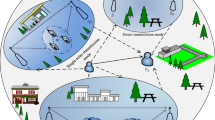Abstract
This paper proposes a joint clustering relay selection and beamforming method for a more realistic cooperative cognitive radio network, in which a secondary network of multiple secondary links and a relay network coexist with a primary network of one primary link. We aim to improve performance of the system in terms of maximizing the received signal power of the secondary destinations, subject to the constraint of received interference plus noise power of the primary destination using the proposed method. Since different relays cooperate differently towards the signals at the secondary and primary destinations, the proposed method can improve the performance of the system and enables the relay network to simultaneously transmit signals of all secondary links toward the destinations by clustering the relays. Results of simulations confirm validity of the method and improve the system performance compared to the existing cooperative beamforming and Zero-Forcing beamforming, in which no relay selection strategy is used.









Similar content being viewed by others
References
Mitola, J., & Maguire, G. Q. (1999). Cognitive radio: Making software radios more personal. IEEE Personal Communications, 6(4), 13–18.
Wyglinski, A. M., Nekovee, M., & Hou, T. (2010). Cognitive radio communications and networks. Cambridge: Academic Press of Elsevier.
Fette, B. A. (2006). Cognitive radio technology. Boston: Newnes Press of Elsevier.
Hossain, E., Niyato, D., & Han, Z. (2009). Dynamic spectrum access and management in cognitive radio networks. Cambridge: Cambridge University Press.
Liu, K. J. R., Sadek, A. K., Su, W., & Kwasinski, A. (2009). Cooperative communications and networking. Cambridge: Cambridge University Press.
Fitzek, F. H. P., & Katz, M. D. (2006). Cooperation in wireless networks: Principles and applications. Berlin: Springer Press.
Xia, M., & Aissa, S. (2012). Cooperative AF relaying in spectrum-sharing systems: Performance analysis under average interference power constraints and Nakagami-m fading. IEEE Transactions on Communications, 60(6), 1523–1533.
Sarma, S., Agnihotri, S., & Kuri, J. (2015). Secure communication in amplify-and-forward networks with multiple eavesdroppers: Decoding with SNR thresholds. Wireless Personal Communications, 85(4), 1945–1956.
Xiong, K., Fan, P., Xu, Z., Yang, H.-C., & Letaief, K. B. (2014). Optimal cooperative beamforming design for MIMO decode-and-forward relay channels. IEEE Transactions on Signal Processing, 62(6), 1476–1489.
Beigi, M. A., & Razavizadeh, S. M. (2009). Cooperative beamforming in cognitive radio networks. In 2009 IEEE conference on wireless days (pp. 1–5).
Liu, J., Chen, W., Cao, Z., & Zhang, Y. J. (2012). Cooperative beamforming for cognitive radio networks: A cross-layer design. IEEE Transactions on Communications, 60(5), 1420–1431.
Hassan, M. H., & Hossain, M. J. (2013). Cooperative beamforming for cognitive radio systems with asynchronous interference to primary user. IEEE Transactions on Wireless Communications, 12(11), 5468–5479.
Rahimi, M. (2015). Achieved data rate of cooperative MIMO in measured channels. Wireless Personal Communications, 85(4), 1925–1943.
Dong, Q., & Li, J. (2015). Joint admission control and beamforming design for the interference cognitive radio network with partial channel state information case. IET Communications, 9(10), 1306–1314.
Balanis, C. A., & Ioannides, P. I. (2007). Introduction to smart antennas. San Rafael: Morgan & Claypool Publishers.
Lim, G., & Cimini, L. J. (2013). Energy-efficient cooperative beamforming in clustered wireless networks. IEEE Transactions on Wireless Communications, 12(3), 1376–1385.
Kumar, N., & Bhatia, V. (2015). Performance analysis of amplify-and-forward cooperative networks with best-relay selection over weibull fading channels. Wireless Personal Communications, 85(3), 641–653.
Eghbali, H., Muhaidat, S., Hejazi, S. A., & Ding, Y. (2013). Relay selection strategies for single-carrier frequency-domain equalization multi-relay cooperative networks. IEEE Transactions on Wireless Communications, 12(5), 2034–2045.
Zou, Y., Champagne, B., Zhu, W. P., & Hanzo, L. (2014). Relay-selection improves the security-reliability trade-off in cognitive radio systems. IEEE Transactions on Communications, 63(1), 215–228.
Cao, J., Zhang, T., Zeng, Z., & Liu, D. (2013). Interference-aware relay selection scheme in cooperative relay networks. In 2013 IEEE international symposium on wireless personal multimedia communications (pp. 1–6).
Cao, J., Zhang, T., Zeng, Z., & Liu, D. (2013). Interference-aware multi-user relay selection scheme in cooperative relay networks. In 2013 IEEE Globecom workshops (pp. 368–373).
Zhao, G., Ma, J., Li, Y., Wu, T., Kwon, Y. H., Soong, A., & Yang, C. (2008). Spatial spectrum holes for cognitive radio with directional transmission. In 2008 IEEE global telecommunications conference.
Chen, H., & Chen, H. H. (2011). Spectrum sensing scheduling for group spectrum sharing in cognitive radio networks. International Journal of Communication Systems, 24, 62–74.
Duran, M. A., & Grossmann, I. E. (1986). An outer-approximation algorithm for a class of mixed-integer nonlinear programs. Journal of Mathematical Programming, 36(3), 307–339.
Geoffrion, A. M. (1972). Generalized benders decomposition. Journal of Optimization Theory and Applications, 10(4), 237–260.
Hiriart, U. J.-B. (2001). Global optimality conditions in maximizing a convex quadratic function under convex quadratic constraints. Journal of Global Optimization, 21(4), 443–453.
Boyd, S., & Vandenberghe, L. (2004). Convex optimization. Cambridge: Cambridge University Press.
Author information
Authors and Affiliations
Corresponding author
Rights and permissions
About this article
Cite this article
Moghaddam, J.Z., Farrokhi, H. & Neda, N. Joint Clustering Relay Selection and Beamforming in Cooperative Cognitive Radio Networks. Wireless Pers Commun 95, 3601–3616 (2017). https://doi.org/10.1007/s11277-017-4014-9
Published:
Issue Date:
DOI: https://doi.org/10.1007/s11277-017-4014-9




